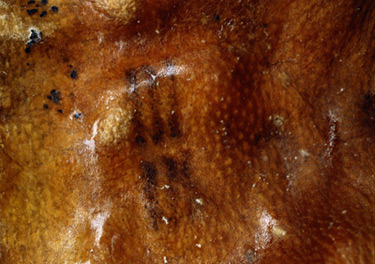TOUCHED BY LYME: The world’s oldest Lyme disease patient

They call him Ötzi the Iceman. He lived and died 5300 years ago, in the Eastern Alps near the modern-day border of Austria and Italy. His frozen remains were discovered accidentally by German hikers in 1991.
Now, his mummified body rests at the South Tyrol Museum of Archaeology in Bolzano, Italy. And scientists from all over the world have been studying him, inside and out, learning amazing information about what life was like back then.
From looking at the well-preserved contents of his stomach, they know what he had for breakfast the day he died (ibex and wild grain). Via other tests, including DNA sequencing, they’ve also determined that Ötzi was lactose intolerant, had hardened arteries, probably had brown eyes—and apparently had Lyme disease.
Recently, I was lucky enough to “meet” Ötzi on his home turf. Well, actually, like other museum visitors, I could only peek at him through a tiny window of his refrigerated holding tank.
And pose next to an artist’s creation of what he may have looked like, back in the day.
According to Nature magazine, researcher Albert Zink and his team analyzed a small specimen of Ötzi’s pelvic bone and found about two-thirds of the genome of Borrelia burgdorferi, the causative agent of Lyme disease.
The article states: “Zink found no other telltale signs of Lyme disease in Ötzi’s preserved tissues, but he speculates that tattoos on the iceman’s spine and ankles and behind his right knee could have been an attempt to treat the joint pain that occurs when the condition goes untreated.”
Credit: South Tyrol Museum of Archaeology/EURAC/Samadelli/Staschitz
Biologist Michelle Ziegler’s “Contagions” blog offers further discussion on this point:
“A common symptom of systemic Lyme disease is joint and muscle pain. One of the earliest observations of Ötzi’s mummy is that he has a lot of tattoos specifically placed over joints and muscle groups in places where strain would be expected. These tattoos do not appear to be decorative or signs of inclusion in a community. Consensus appears to have formed early on that these tattoos were medicinal, probably for pain relief. Scans of the mummy do suggest some arthritis. With his lifestyle, an approximately 45-year-old man is expected to have some arthritis and pain. Both atherosclerosis, and evidence of joint pain and some arthritis can be explained by other means, but when taken together with the B. burgdorferi DNA make a compelling case that Lyme disease contributed to his overall state of health.”
Credit: South Tyrol Museum of Archaeology/EURAC/Samadelli/Staschitz
In all, Ötzi has 61 tattoos. Were they actually a form of acupuncture, intended to ease his aching joints? Unknown. If so, did they ever provide any symptomatic relief? Unknown.
We also don’t know how much longer Ötzi might have survived with whatever constellation of Lyme symptoms he may have endured. His life ended when somebody shot an arrow in his shoulder. His body would soon freeze solid, to be covered by ice and snow. And the rest is, well, history.
Ötzi continues to tantalize us with this window on the past. Are there still more secrets to be discovered?
Learn more about Ötzi at the museum’s website.
TOUCHED BY LYME is written by Dorothy Kupcha Leland, LymeDisease.org’s VP for Education and Outreach. She is co-author of When Your Child Has Lyme Disease: A Parent’s Survival Guide. Contact her at dleland@lymedisease.org.























This has mystified me for some time. This indicates Lyme has been in Europe for in excess of 5300 years thus many immigrates from Europe carried it here.
Is it possible that Lyme has mutated to the current strain that has been such an issue for so many people.
If you look back 50 or 100 years people got sick from diseases including cancers and they called it “consumption” and died without a real diagnosis.
I saw a PBS documentary about the Iceman. They also said that he had Lyme Disease, arthritis, and heart disease. They suggested that his arthritis was caused by Lyme. They also said he had bone lesions, and considered them another sign of Lyme.
The documentary makers also had a theory that he was killed by a member of his own tribe. When he died, he was carrying a copper hatchet, high tech at that time. An enemy tribe would’ve stolen it, but if one of his own people took it, everyone would know whose it was. I wonder if Lyme was causing him to act crazy and that’s why he was killed.
I agree with you that Lyme and other TBDs could’ve been the cause of many unexplained diseases over the years. I agree that many European immigrants could’ve been infected when they came here. There is a European and American strain, and since Lyme can be passed from mother to unborn baby, it could explain why some Americans with Lyme symptoms don’t test positive.
However, I don’t believe they brought it here. There’s evidence of Lyme here before large numbers of immigrants. Native Americans avoided traveling in certain areas in the spring, when ticks are bad. They saw people get sick after tick bites. Lyme bacteria was found in beaver pelts, trapped out west in the early 1800’s, when a few trappers were the only white people there.
dorothy, that was really interesting esp. the face they put together based upon all the things they found!!
is it a free museum or reasonably priced to get into this no. 1 person with lyme? thanks!
bettyg
Betty, it costs 9 euros (about 10 bucks) to get into the museum. However, if you add in the flight to Italy and ground transportation to Bolzano, it ups the price a bit. 🙂 DKL
PS. The museum’s website (linked in the article above) has lots of information, including videos you can watch on your computer.
dorothy, thank you for additional info and we can SURF the web more and get a FEEL for being there at “affordable” prices!! betty 😉
Dorothy, you are a wonderful story-teller! Thank you for sharing the interesting details of your recent trip. It is so tantalizing to have some material facts and only speculation to fill in the blanks. Those tattoos are especially curious.
Phyllis Mervine
This is not directly related to Otzi, but to Lyme disease advocacy in general.
Another famous person with Lyme could be Charles Darwin.
He got sick about age of 22 before sailing on Beagle (before exposure to tropic diseases like Chagas)
Through the rest of his life he suffered from symptoms of heart palpitations, fatigue, headache, tremors, diarrhea, vomiting.
His daughter died of similar disease at age ten.
Here is a link to wikipedia article:
https://en.wikipedia.org/wiki/Charles_Darwin%27s_health
I’ve seen fifty doctors had ever test and finally found a doctor after forty years who has helped me so much. I have Lyme and several co- infections. On medication for life now. Starting my life at 57. Don’t give up guys.
The same day that this story appeared in my Inbox several months ago, I learned from 23&Me that the iceman and I are in the same small haplogroup. My Lyme doctor told me eight years ago when I was diagnosed that he suspected that I had been born with Lyme disease. He may have reached this conclusion based on the fact that I told him that my mother and two sisters had similar symptoms all their lives and on the fact that my health issues traced back to childhood. If he is right, I’ve had Lyme for 74 years and was 66 before I got a diagnosis. I’m sure there are others with similar stories.